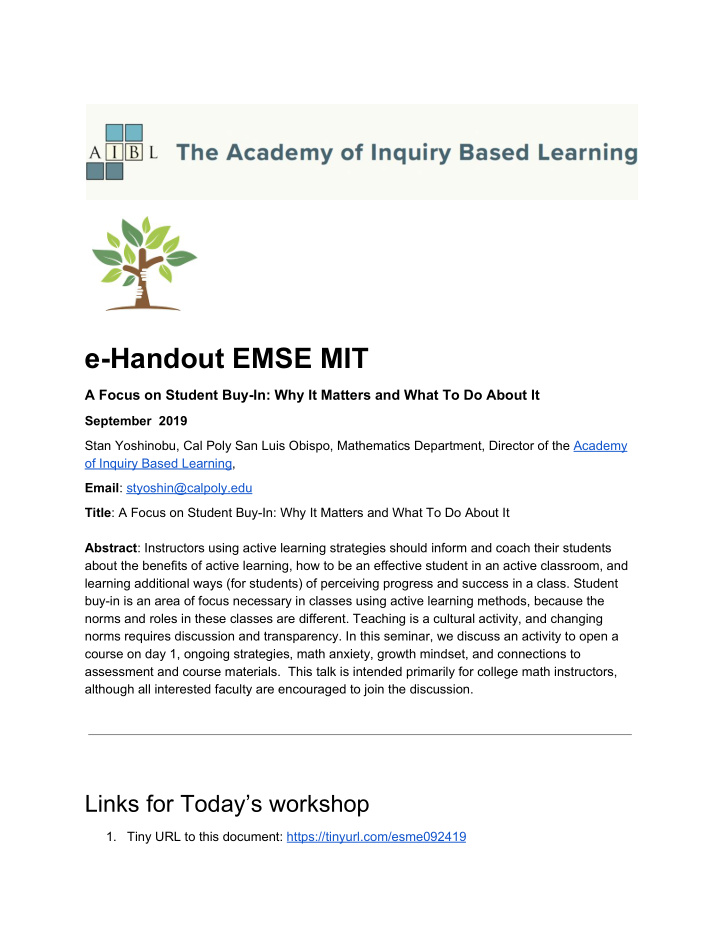



e-Handout EMSE MIT A Focus on Student Buy-In: Why It Matters and What To Do About It September 2019 Stan Yoshinobu, Cal Poly San Luis Obispo, Mathematics Department, Director of the Academy of Inquiry Based Learning , Email : styoshin@calpoly.edu Title : A Focus on Student Buy-In: Why It Matters and What To Do About It Abstract : Instructors using active learning strategies should inform and coach their students about the benefits of active learning, how to be an effective student in an active classroom, and learning additional ways (for students) of perceiving progress and success in a class. Student buy-in is an area of focus necessary in classes using active learning methods, because the norms and roles in these classes are different. Teaching is a cultural activity, and changing norms requires discussion and transparency. In this seminar, we discuss an activity to open a course on day 1, ongoing strategies, math anxiety, growth mindset, and connections to assessment and course materials. This talk is intended primarily for college math instructors, although all interested faculty are encouraged to join the discussion. Links for Today’s workshop 1. Tiny URL to this document: https://tinyurl.com/esme092419
2. PNAS Paper “Measuring actual learning versus feeling of learning in response to being actively engaged in the classroom” - Louis Deslauriers, Logan S. McCarty, Kelly Miller, Kristina Callaghan, and Greg Kestin ( Link ) Outline of Talk ● Part 1: Preamble on why student buy-in is so important ● Part 2: Topics 1 (Setting the stage, Day 1, Ongoing strategies, growth mindset,...) ● Part 3: Discussion 1 ● Part 4: Topics 2 (co-opt “smart” by pointing out success, course content, assessment, organizing tasks...) ● Part 5: Discussion 2 ● Part 6: Outro Resources 1. AIBL resources that support instructor learning about IBL, with a focus on student buy-in a. 10+ videos on productive failure and growth mindset. ( Link ) b. Student buy-in posts have been organized in this post on the IBL Blog . c. Student buy-in is important. One issue to work on is growth mindset, and a list of videos has been compiled HERE that can be used to move students from a fixed to a growth mindset. These videos can be assigned as homework. Students could watch a few videos and write a reflection on these videos. d. Professor Dana Ernst, Northern Arizona University, has a post on “Setting the Stage” Check it out here: http://danaernst.com/setting-the-stage/ e. IBL Workshop Zero is a slide deck that goes through the basic IBL ideas. LINK f. We also have a video series for a deeper look into IBL basics. g. IBL Course Case Studies can be used to look at a variety of IBL courses and see different parts of “Big Tent IBL.” LINK h. The Academy of Inquiry Based Learning, www.inquirybasedlearning.org
i. AIBL has collected student voices, which can be useful in sharing the benefits of IBL ( LINK ). The full video with Alfred and Diana is HERE . These videos address benefits of IBL to students in their own voices. j. The IBL Blog is where SY posts about IBL ideas and methods. An organized playlist is put HERE . k. AIBL Email List. Send an email to styoshin@calpoly.edu to be added to the email list. 2. Resources that offer research and professional support for using IBL (in Math), in case instructors are curious about the evidence base supporting the use of active learning. a. The Conference Board of the Mathematical Sciences (CBMS) published their CBMS Active Learning Statement , based on the overwhelming evidence in support of active learning methods in college mathematics. b. E&ER research and evaluation about IBL in college math. See the Reports section page for a two-page summary that may be handy for sharing. The DELTA conference paper (Laursen, 2013) is a readable overview of findings about student outcomes of IBL. c. The four pillars are discussed in a research commentary by Laursen & Rasmussen (2019). I on the prize: Inquiry approaches in undergraduate mathematics. International Journal of Research in Undergraduate Mathematics Education, https://doi.org/10.1007/s40753-019-00085-6 If you can’t get through the paywall, feel free to contact Sandra Laursen for a copy. 3. Resources for structuring active learning a. SY’s blog posts about Think-pair-share . b. Random number generator is at https://www.random.org/ c. Customizing Think-pair-share , “the atomic unit of classroom engagement,” 9/2015 blog post at Agile Learning by Derek Bruff at Vanderbilt University’s Center for Teaching. d. Basics about the jigsaw method, from the Social Psychology Network (2000-2019). e. More info, and some variations on the jigsaw, from Jennifer Gonzalez at Cult of Pedagogy (4/15/15). f. This cheat sheet for planning active learning works just as well for planning active PD as it does for planning active math classes. From Vanderbilt’s Center for Teaching. g. Standards-Based Grading (An Example) Link h. Liberating Structures is a collection of strategies (for running meetings, but can be used and adapted for classroom). Menu http://www.liberatingstructures.com/ls/
i. 1-2-4-All (like Think-Pair-Share) http://www.liberatingstructures.com/1-1-2-4-all/ ii. Stated reasons for using 1-2-4-All 1. Engage every individual in searching for answers 2. Avoid over-helping and the overcontrol-dependency vicious cycle 3. Create safe spaces for expression, diminish power differentials 4. Express “silent” conversations and expand the diversity of inputs 5. Enrich quality of observations and insights before expression 6. Build naturally toward consensus or shared understanding 4. Mastery-Based Final Exam sample from Calculus 1 ( Link )
Recommend
More recommend